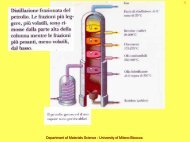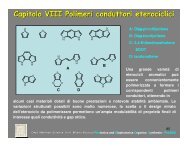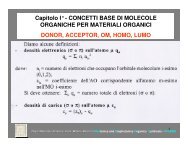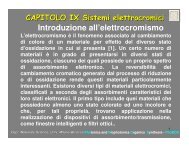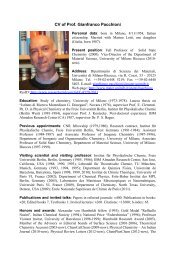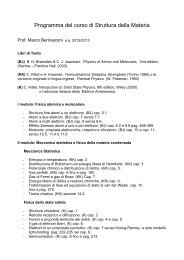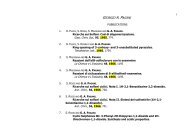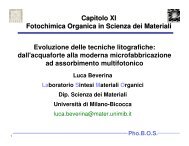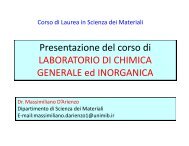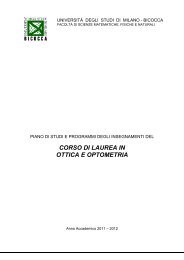New Ï-Extended Watersoluble Squaraines as Singlet Oxygen ...
New Ï-Extended Watersoluble Squaraines as Singlet Oxygen ...
New Ï-Extended Watersoluble Squaraines as Singlet Oxygen ...
Create successful ePaper yourself
Turn your PDF publications into a flip-book with our unique Google optimized e-Paper software.
2-(N-(4-bromophenylhydrazonomethyl)-1-methylpyrrole (6d). A mixture of 4-<br />
bromophenylhydrazine hydrochloride (3.00 g, 13.42 mmol) and 5a (1.47 g, 13.42 mmol) w<strong>as</strong><br />
suspended in deg<strong>as</strong>sed THF (50 ml) and stirred at room temperature for 6 h under nitrogen<br />
atmosphere. The color turns from light yellow to dark blue. The solvent w<strong>as</strong> removed and the black<br />
sticky residue purified by chromatography (SiO 2, CH 2 Cl 2 ) to give the pure compound <strong>as</strong> a yellow<br />
powder (1.02 g, 3.67 mmol, 33 %). 1 H NMR (CDCl 3 ) δ 7.68 (1H, s), 7.34 (2H, d, J = 8.8 Hz), 6.88<br />
(2H, d, J = 8.8 Hz), 6.71 (1H, t, J = 2.2 Hz), 6.34 (1H, dd, J = 3.7, 1.8 Hz), 6.14 (1H, dd, J = 3.6,<br />
2.6), 3.96 (3 H, s).<br />
1-[4-pyridyl]-2-(N-(3,6,9-trioxadecyl)-2-pyrrolyl)ethylene (7a). tBuOK (2.56 g, 22.80 mmol)<br />
w<strong>as</strong> added portionwise under nitrogen atmosphere to a solution of 4-picoline (1.93 g, 20.70 mmol)<br />
and 5b (5.00 g, 20.74 mmol) in anhydrous DMF (20 ml). The resulting red solution w<strong>as</strong> stirred at<br />
80 °C for 1 h and at room temperature overnight. The reaction mixture w<strong>as</strong> poured into 200 ml of<br />
crushed ice to give a yellow suspension that w<strong>as</strong> extracted with AcOEt (3 x 200 ml). The combined<br />
organic ph<strong>as</strong>e w<strong>as</strong> w<strong>as</strong>hed with brine (4 x 200 ml), dried over Na 2 SO 4 and evaporated affording the<br />
product <strong>as</strong> a dark yellow oil that w<strong>as</strong> used directly without further purification in the subsequent<br />
step (5.00 g, 15.80 mmol, 76.3 %). 1 H NMR (DMSO-d 6 ) δ 8.49 (2H, d, J = 5.5 Hz), 7.27 (2H, d, J =<br />
5.5 Hz), 7.24 (1H, d, J = 16.1 Hz), 6.77 (1H, s, broad), 6.73 (1H, d, J = 16.1 Hz), 6.58 (1H, d, J =<br />
3.5 Hz), 6.17 (1H, t, J = 3.2 Hz), 4.16 (2H, t, J = 5.6 Hz), 3.72 (2H, t, J = 5.6 Hz), 3.59-3.53 (6H,<br />
m), 3.47 (2H, m), 3.23 (3H, s).<br />
1-[4-quinolyl]-2-(N-(3,6,9-trioxadecyl)-2-pyrrolyl)ethylene (7b). tBuOK (1.12 g, 10.01 mmol)<br />
w<strong>as</strong> added portionwise under nitrogen atmosphere to a solution of 4-methylquinoline (1.30 g, 9.10<br />
mmol) and 5b ( 2.20 g, 9.12 mmol) in anhydrous DMF (15 ml). The resulting red fluorescent<br />
solution w<strong>as</strong> stirred at 80 °C for 1 h and at room temperature overnight. The reaction mixture w<strong>as</strong><br />
poured into 200 ml of crushed ice to give a red-orange suspension that w<strong>as</strong> extracted with AcOEt (3<br />
x 200 ml). The combined organic ph<strong>as</strong>e w<strong>as</strong> w<strong>as</strong>hed with brine (4 x 200 ml), dried over Na 2 SO 4 and<br />
evaporated affording a red oil that w<strong>as</strong> purified by chromatography (SiO 2 AcOEt) to give the<br />
product <strong>as</strong> an orange oil (1.92 g, 5.50 mmol, 60.0 %). 1 H NMR (CDCl 3 ) δ 8.85 (1H, d, J = 4.7 Hz),<br />
8.21 (1H, d, J = 8.3 Hz), 7.72 (1H, t, J = 8.5 Hz), 7.55 (1H, d, J = 5.1 Hz), 7.57 (1H, d, J = 8.5 Hz),<br />
7.58 (1H, d, J = 15.8 Hz), 7.31 (1H, d, J = 15.8 Hz), 6.83 (1H, dd, J = 2.5, 1.7 Hz), 6.72 (1H, dd,<br />
3




